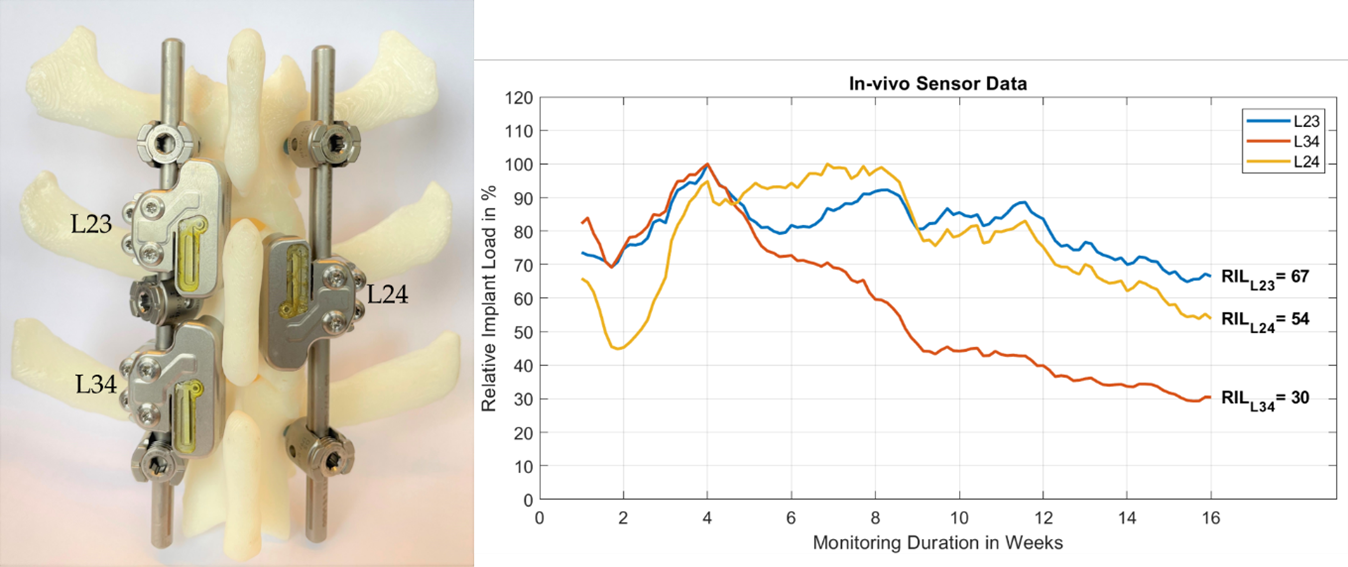Feasibility of the AO Fracture Monitor for measuring spinal fusion
Background
CT-based monitoring of spinal fusion cases has multiple limitations. Beside the radiation exposure to the patient, the interpretation of CT images is highly subjective. Furthermore, CT only provides a coarse visual overview (snapshots) of the fusion process as no continuous data is available. The AO Fracture Monitor is an implantable sensor system allowing for continuous and wireless implant load monitoring. This may also provide an objective means to monitor the progress of spinal fusion to rapidly react to complications such as pseudoarthrosis or implant loosening
Goal
To investigate feasibility of applying the AO Fracture Monitor measurement principle to spinal fusion assessment.
Results
After a successful pilot animal study, which allowed to assess fusion progression by continuous implant load monitoring (Figure) three additional sheep were operated. In each animal two separate lumbar motion segments underwent posterolateral fusion surgery. The AO Fracture Monitor was bilaterally attached to the stabilizing posterior instrumentation. The aim of this ongoing study is to confirm the finding from the first pilot animal.
Furthermore, an in vitro model of a posterolateral and an interbody fusion approach was developed and biomechanically investigated. The simulated bony union of the segment was compared to its destabilized state by means of change in range of motion and strain changes measured on the posterior instrumentation during different loading modes. Torsional strain on the instrumentation under axial rotation loading reduced significantly due to simulated fusion in both in-vitro models, whereas bending strain during flexion-extension loading only decreased for the posterolateral fusion model.
Preliminary in vivo and in-vitro data support the hypothesis that continuous rod load monitoring can provide a reliable and objective means to assess the progress of fusion and rapidly react to complications. After completing the feasibility phase of this project, a new sensor system prototype – based on the AO Fracture Monitor – is being developed to meet the requirements for spinal application.
-
PublicationWindolf M, Heumann M, Varjas V, Constant C, Ernst M, Richards RG, Wilke HJ, Benneker LM. Continuous Rod Load Monitoring to Assess Spinal Fusion Status - Pilot In Vivo Data in Sheep. Medicina, 2022. 58(7): p. 899.
Heumann M, Jacob A, Gueorguiev B, Richards RG, Benneker LM
Load changes on a short-segment posterior instrumentation after transosseous disruption of L3 vertebra - A biomechanical human cadaveric study
Global Spine J. 2024:21925682241282276
https://doi.org/10.1177/21925682241282276 -
PresentationWindolf M, Heumann M, Varjas V, Constant C, Ernst M, Richards RG, Wilke HJ, Benneker LM. Continuous Rod Load Monitoring to Assess Spinal Fusion Status - Pilot In Vivo Data in Sheep. Medicina, 2022. 58(7): p. 899.
Heumann M, Benneker LM, Constant C, Ernst M, Richards RG, Wilke H-J, Windolf M. Decreasing spinal implant load indicates progression of posterolateral fusion when measured continuously – in vivo proof of concept in sheep. 2023 Swiss Orthopaedics (oral)
Heumann M, Benneker LM, Constant C, Ernst M, Richards RG, Wilke H-J, Windolf M. Decreasing spinal implant load indicates progression of posterolateral fusion when measured continuously – in vivo proof of concept in sheep. 2023 Spine Loading and Deformation (oral)
-
Partner
Benneker LM (Prof), Inselspital Bern, Switzerland
Davies E, University Hospital Southampton, UK
Wilke HJ (Prof), University Ulm, Ulm, Germany


